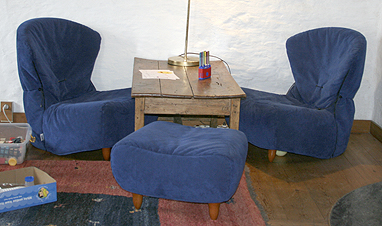Antonia’s never watched a lot of TV/Video, and when we started homeschooling it was part of the initial setup that there would be no TV watching until the evening, except very rare treats or educational things. It’s not that we’re completely against that particular medium. We’ve always weighed the pros with the cons.
Pro
She got a lot cool ideas from watching TV and video that she was motivated to try out in the real world: kite flying, skating, various crafts, and of course she had parents who made sure the things really did get tried out.
Con
She learned some undesirable behaviours. Being a sweet little girl whose parents supervised her viewing, this wasn’t so much to do with violence. But we did notice her modelling her behaviour on female characters in ways that we felt were undesirable, and ultimately detrimental to her.
Pro
She learned about the difference between images and reality by making comparisons between what she saw on the screen and the equivalent in life, because we made sure she had opportunities to do so.
Con
She got to watch plenty of dumbed down, repetitive junk, adverts, and other nonsense.
Pro
Some films that she watched spoke to something very deep in her, and I think she benefited from having them in her life. There were also documentaries in which she saw things she remembers to this day.
Con or neutral, depending on point of view
I think TV contributed to making her very ‘picture-orientated’. And conversely, less word-orientated. Although she reads very well and enjoys being read to, she only wants books with pictures in.
Pro (probably)
It might have helped her French.
On the whole, we were more balanced towards the pros. But just lately the balance tipped.
Con
The things she has been watching are even more dumbed down now that she is older. She’s certainly getting less in the way of new ideas or psychological fulfillment. But I’m not very enthusiastic about the programs for older kids – they seem to have thrown any notion of quality or meaningful content out of the window when making them.
Con
When she was little(r), lots of repetition was good because it helped her decode what she was watching. Now I feel uncomfortable that she clearly relies on everything being repeatable ad infinitum. It never occurs to her to actually give her full attention to things. But repetition seems inevitable or at least it’s always possible, with too much TV or video viewing.
Con
I didn’t like that watching TV had become a habit: something she systematically did in the evenings. And of course, she had to watch something to feed the habit, even if she’d seen it a hundred times, didn’t really like it, didn’t want to see it much that day.
Con
And I could just see her flip into passive mode! Whereas, when she was little, I could see her actively engaged in trying to understand, compare, etc…
Con
We felt there were a lot of other things she could be doing. I suppose our days are seeming a bit shorter lately. She stopped napping finally, but goes to bed earlier. We’re out just about every afternoon (nature walks, city walks, socialising). We do about an hour and a half of lessons in the mornings. I wanted her to have a lot more free time to do her own thing.
TV Withdrawal
The disappearance of TV time went rather well. I did it while Mike was away, and everything seemed different anyway. I told her we were going to do without TV for a bit, and made sure I was ready with an activity, a story or something like that at TV time. Every day for a week and a half, she asked me if she was going to get to watch TV that day. I said “not today” and she went off and did something cool and productive without another word. At the end of a week and a half, she stopped asking. The habit seems to be broken, rather quickly too. I think that proves that the activity had no real value for her.
She hasn’t been screen free all this time. She’s been to the cinema, which is something I’m promoting now. She’s watched a few films and documentaries, played some computer games, watched Brainpop, she’s even watched a bit of junk TV with her friends. But it’s not linked to a particular time any more, it’s not a regular event, and it’s generally something that’s been picked because she really wanted to watch it, not just what the box was dispensing that day.
